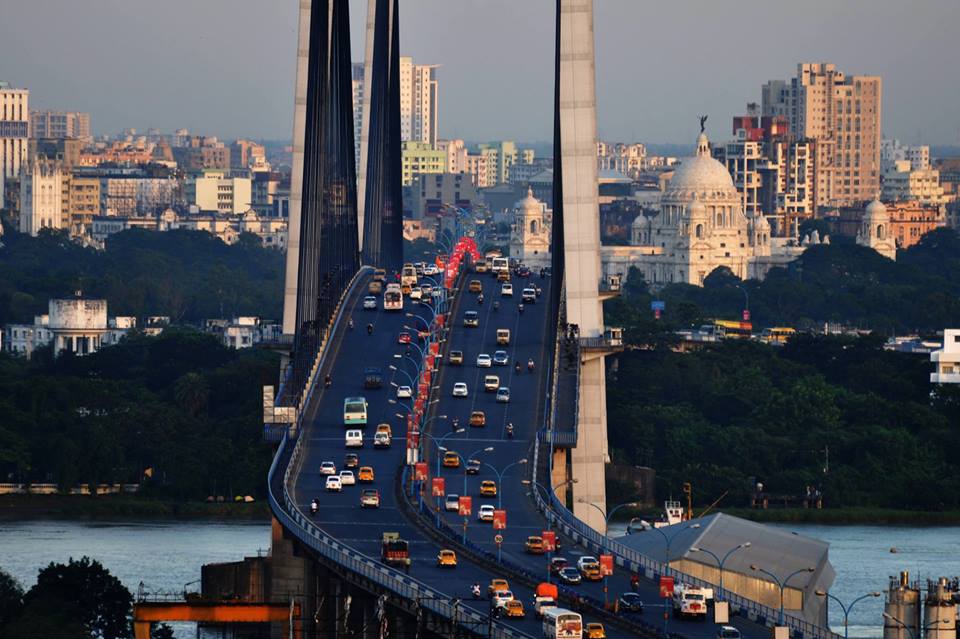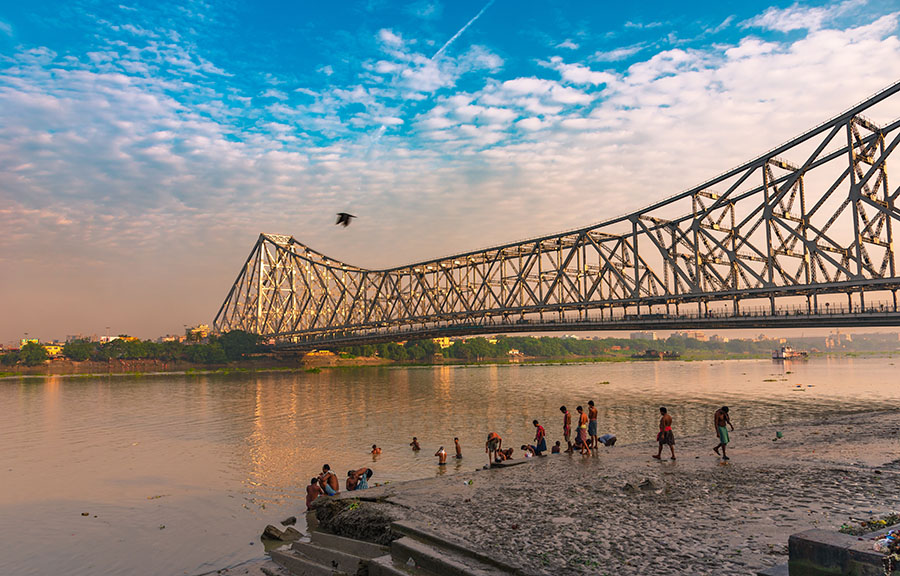
Are the twin cities of Kolkata and Howrah sinking? Will they be overtaken by the same fate as that of Bangkok or Mexico City with subsiding roads, damaged buildings, twisted water supply pipes and leaning high-rise apartment blocks? These questions were posed in a study almost 25 years ago by hydrogeologist Pradip Sikdar and others. The 1996 paper was the first to raise the possibility of land subsidence in the city and was met with scepticism, even amusement.
Today, with more sophisticated measurements, the answer is clearer and no one is laughing: groundwater extraction is causing parts of Kolkata to sink. In the most recent, and comprehensive, study published in January, scientists S Suganthi and L Elango used satellite data to compare land and water level trends across Kolkata between 2003 and 2010. They found total land subsidence of between 13mm to 52mm in this period — or 1.3cm to 5.2cm over seven years — in the areas of Baguiati, Ultadanga, Beleghata, Tangra, Nayabad, Rajabazar, Macchua Bazar, and around Calcutta University.
Salt Lake and the area around Science City saw the greatest declines — of up to 8mm a year. Subsidence was higher in between 2007 and 2010 in some areas.
This sinking is smaller than those seen in other global megacities, and these findings are a little lower than some previous Kolkata studies have shown. That's largely due to the fact that Kolkata has an abundant freshwater source in the Hooghly. Jakarta, by comparison, is sinking by as much as 7 inches in some neighbourhoods (sea level rise contributes) and Mexico City, which is dependent on groundwater, is falling by as much as 12 inches a year.
Still, scientists say the cumulative effect of small declines is dangerous.
"Risk will build over time," says Elango, a professor of geology at Anna University in Chennai. Roads are not yet caving in or water pipes twisting. But Elango's survey — as well as others' — found tilted buildings and cracked walls in Salt Lake.
Subsidence could also increase flooding risk in a city often ranked atop of lists of the world's most climate-threatened cities. Built on swamp and silt, this delta megalopolis of 14 million is considered highly vulnerable to increasing rainfall, rising seas, and storm surges.
And the recent spurt of high-rise complexes, especially off EM Bypass, with their deep tubewells and high water demands, and in the urbanising fringes in the south, suggests the threat of further subsidence will not vanish any time soon.
"Kolkata's geology is such that if you go deep underground in an unplanned way, a subsidence situation may arise," says S P Sinha Ray, emeritus president of the Centre for Ground Water Studies in Kolkata, adding, "We need to be very cautious in some areas."
Kolkata's aquifers run at a depth of 50-300 metres, below a thick layer of compressible clay. Removing too much groundwater causes the water table to drop, reducing the pressure that helps hold up the upper layers. These layers then begin to compact. Deltas can also naturally sink over time but extraction of groundwater — or oil or gas — leads to much faster falls.
Both Sinha Ray and Sikdar point to the Metro tunnelling disaster in Bowbazar last year as an example of land subsidence in an accelerated time-frame. When the contractor's boring machine inadvertently hit a shallow aquifer, water was drawn out into the tunnel. Because the upper clay layer in this location was only 14 metres thick — compared to 40 metres in other parts of the city — it crumpled quickly, leading to the collapse of buildings above.
"In that case, the subsidence was very quick," says Sinha Ray.
Older studies show that subsidence occurred in the 1990s as well, when the municipality began to sink borewells and larger tubewells in rapidly developing areas to meet increased water demand. A remote sensing study found the area around Calcutta University, Rajabazar, and Macchua Bazar had subsided by up to 6.5mm a year in that decade. Another study, by A K Bhattacharya, found that Tolly's Nullah and Sonarpur in south Kolkata had subsidence rates of 9.67mm per year and 10.85mm per year in the late 90s.
Recent studies flag Salt Lake and other parts of East Kolkata for risk. Last year, the Geological Survey of India, which has installed highly sophisticated GPS systems in 22 locations across the country, said they had found a fall between 2016 and 2019 at their Salt Lake station of 18.79mm a year.
That's double Elango's findings. The difference could be due to the fact that the GSI used more localised data and the timeframe was more recent, says Elango. "If the GSI numbers are right, that's really alarming," he says, adding, "In 10 years, that would add up to over half a foot fall in ground level."
Sinking in Salt Lake isn't very surprising, say experts. Even if tectonic shifts are playing a role, as the GSI suggested, the township is also built on lakes and marshes filled in with sediments brought from the Hooghly in the 1960s. This infill would have been slowly compacting over the years.
As importantly, the area has been developing rapidly (34% of new residential real estate between 2006-2018 was built in East Kolkata areas, according to Anarock), increasing the demand for water. Studies show that the water table in Salt Lake dropped by 4 metres between 2007 and 2010.
Other areas of concern are the EM Bypass and Park Circus, says Sinha. And new development around and over the verdant East Kolkata Wetlands, historically situated at a lower level than the old city, would also up flood risk, as it paves over a natural drainage area.
The solution to the problem is simple, say experts, though not easy to implement: regulating groundwater use.
Tokyo brought down land subsidence from as much as 10cm a year in the 1960s to almost zero today by controlling pumping from wells. Shanghai, which introduced land subsidence prevention rules in 2013, has also seen subsidence rates fall by regulating groundwater withdrawal (see box).
In Kolkata, too, local authorities have made efforts to augment freshwater supply. Officials say that since 2010, partly due to concerns about arsenic contamination, new and expanded treatment plants have helped reduce their groundwater supply from 45 million gallons a day to 25 million gallons a day.
"The government is trying to take care that a situation does not develop," agrees Sinha Ray. The problem is that private extraction has gone up, balancing out the city's increased surface water supply, says Sikdar. "With all this real estate coming up, where is the water coming from?" he asks.
The corporation banned new bore-wells in 2010 but has not been able to fully implement it. Sources in the KMC say there could be as many as 800 bore-wells in apartment blocks. Sinha Ray estimates that total groundwater withdrawal today may be 75-100 million gallons a day.
The corporation says it plans to add another 70 million gallons to its filtered freshwater supply, including to the high-rises off EM Bypass. By the end of this month itself, the capacity of the Garden reach water treatment plant will go up by 50 million gallons, and the Dhapa plant by 20 million gallons by 2022.
Corporation sources said that the construction of small (or 'capsule') water booster pumping stations has also been given a lot of importance. These would ensure drinking water supply to neighbourhoods that are heavily dependent on groundwater.
Scientist Sinha Roy believes that while the subsidence threat is not "immediate", certain steps are required to ward off the potential threat: recharging groundwater, putting a stop to the practice of withdrawing groundwater.
He praised KMC's initiative of augmenting surface water at its treatment plants. "It is encouraging that the corporation recognized the threat 10 years ago and accordingly arranged for augmentation of surface water at its treatment plants. This will go a long way in minimizing groundwater depletion," he adds.
Elango agrees that groundwater recharge is an important remedial measure. And because Kolkata's aquifers are charged at a distance from the city — in areas that are also developing — Sikdar believes mandatory rainwater harvesting is also needed. The city receives an average of 160cm of rainfall annually.
Rules currently mandate rainwater harvesting for rooftops 20,000 square feet, but few building have such a large footprint, he says. "These huge towers are taking out water from the ground and returning nothing back," says Sikdar. "What we need is a mass rainwater harvesting movement."
— (With inputs from Saikat Ray)












